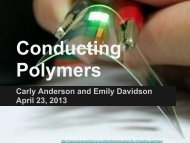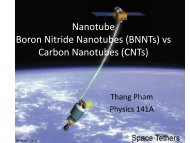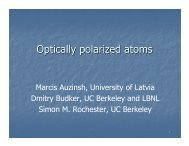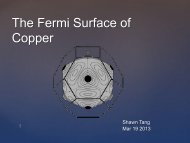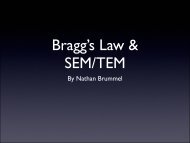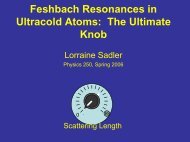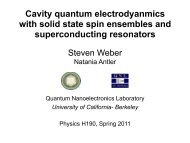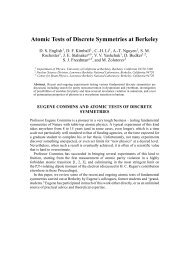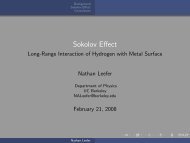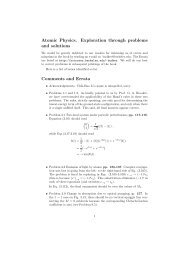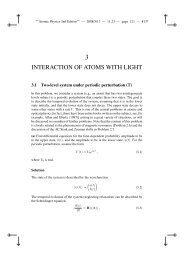Resonant nonlinear magneto-optical effects in atomsâ - The Budker ...
Resonant nonlinear magneto-optical effects in atomsâ - The Budker ...
Resonant nonlinear magneto-optical effects in atomsâ - The Budker ...
Create successful ePaper yourself
Turn your PDF publications into a flip-book with our unique Google optimized e-Paper software.
21<br />
tical electric fields causes atoms to acquire orientation<br />
along the direction of the magnetic field, <strong>in</strong> a process<br />
known as alignment-to-orientation conversion (AOC). As<br />
discussed <strong>in</strong> Sec. II.A, an atomic sample oriented along<br />
the direction of light propagation causes <strong>optical</strong> rotation<br />
via circular birefr<strong>in</strong>gence, s<strong>in</strong>ce the refractive <strong>in</strong>dices for<br />
σ + and σ − light are different.<br />
<strong>The</strong> evolution of atomic polarization lead<strong>in</strong>g to AOCrelated<br />
NMOR is illustrated for an F = 1 → F ′ = 0<br />
transition <strong>in</strong> Fig. V.C(b). In the first plot, the atoms<br />
have been <strong>optical</strong>ly pumped <strong>in</strong>to an aligned state by<br />
x-polarized light (they have been pumped out of the<br />
“bright” x-absorb<strong>in</strong>g state <strong>in</strong>to the dark states). If the<br />
atomic alignment is parallel to the <strong>optical</strong> electric field,<br />
the light shifts have no effect on the atomic polarization—<br />
they merely shift the energies of the bright and dark<br />
states relative to each other. However, when the magnetic<br />
field along ẑ causes the alignment to precess, the<br />
atoms evolve <strong>in</strong>to a superposition of the bright and dark<br />
states (which are split by the light shifts), so <strong>optical</strong>electric-field-<strong>in</strong>duced<br />
quantum beats occur. <strong>The</strong>se quantum<br />
beats produce atomic orientation along ẑ (appear<strong>in</strong>g<br />
<strong>in</strong> the second plot and grow<strong>in</strong>g <strong>in</strong> the third plot) caus<strong>in</strong>g<br />
<strong>optical</strong> rotation due to circular birefr<strong>in</strong>gence.<br />
<strong>The</strong> atomic orientation produced by AOC is proportional<br />
to P× E, where P is the macroscopic <strong>in</strong>duced<br />
electric-dipole moment (Eq. 7). <strong>The</strong> quantity P× E is<br />
proportional to the light shift, which has an antisymmetric<br />
dependence on detun<strong>in</strong>g of the light from the atomic<br />
resonance. Thus (<strong>in</strong> the Doppler-free case), net orientation<br />
can only be produced when light is detuned from<br />
resonance. This is <strong>in</strong> contrast to NMOR at low light powers,<br />
which is maximum when light is tuned to the center<br />
of a Doppler-free resonance.<br />
It turns out that <strong>in</strong> applications to <strong>magneto</strong>metry (Sec.<br />
XII.A), the light power for which optimum <strong>magneto</strong>metric<br />
sensitivity is obta<strong>in</strong>ed is sufficient to produce significant<br />
AOC, so this effect is important for understand<strong>in</strong>g<br />
the properties of an NMOR-based <strong>magneto</strong>meter. For<br />
example, if two atomic species (e.g., Rb and Cs) are<br />
employed <strong>in</strong> an NMOR-based <strong>magneto</strong>meter, AOC generates<br />
a longitud<strong>in</strong>al sp<strong>in</strong> polarization. Sp<strong>in</strong>-exchange<br />
collisions can then couple the polarizations of the two<br />
atomic species. [Related AOC-<strong>in</strong>duced coupl<strong>in</strong>g of polarization<br />
of different ground-state hfs components <strong>in</strong> 85 Rb<br />
was studied by Yashchuk et al. (1999b)].<br />
Although the phenomenon of AOC has been studied <strong>in</strong><br />
a variety of different contexts (Dovator and Okunevich,<br />
2001; Hilborn et al., 1994; Kuntz et al., 2002; Lombardi,<br />
1969; P<strong>in</strong>ard and Am<strong>in</strong>off, 1982), its role <strong>in</strong> NMOE was<br />
only recently recognized by Okunevich (2000) and <strong>Budker</strong><br />
et al. (2000a). However, as is usual with “new”<br />
phenomena, a closely related discussion can be found <strong>in</strong><br />
the classic literature (Cohen-Tannoudji and Dupont-Roc,<br />
1969).<br />
VI. SYMMETRY CONSIDERATIONS IN LINEAR AND<br />
NONLINEAR MAGNETO-OPTICAL EFFECTS<br />
<strong>The</strong> <strong>in</strong>teraction of light with a dielectric medium<br />
is characterized by the electric polarizability of the<br />
medium, which may be equivalently described by various<br />
frequency-dependent complex parameters: the electric<br />
susceptibility (χ), the dielectric permittivity (ε) and<br />
the <strong>in</strong>dex of refraction (ñ). <strong>The</strong> imag<strong>in</strong>ary parts of these<br />
quantities determ<strong>in</strong>e light absorption by the medium,<br />
while their real parts describe the dispersion, i.e., the<br />
phase shifts that a light wave travers<strong>in</strong>g the medium experiences.<br />
For isotropic media, the above parameters<br />
are scalar quantities and the <strong>in</strong>teraction of the medium<br />
with the light is <strong>in</strong>dependent of the light polarization.<br />
In anisotropic media, the <strong>in</strong>teraction parameters are tensors,<br />
and the <strong>in</strong>cident <strong>optical</strong> field and the <strong>in</strong>duced electric<br />
polarization are no longer parallel to each other. <strong>The</strong><br />
<strong>in</strong>duced polarization acts as a source of a new <strong>optical</strong><br />
field with a polarization (and amplitude) that differs from<br />
the <strong>in</strong>cident field and which adds coherently to this field<br />
as light propagates through the medium. This leads to<br />
macroscopic phenomena such as dichroism and birefr<strong>in</strong>gence.<br />
Thus l<strong>in</strong>ear and <strong>nonl<strong>in</strong>ear</strong> <strong>magneto</strong>-<strong>optical</strong> <strong>effects</strong><br />
<strong>in</strong> vapors can be regarded as the result of the symmetry<br />
break<strong>in</strong>g of an <strong>in</strong>itially isotropic medium due to its<br />
<strong>in</strong>teraction with an external magnetic field, and for the<br />
<strong>nonl<strong>in</strong>ear</strong> <strong>effects</strong>, <strong>in</strong>tense polarized light.<br />
An <strong>in</strong>cident light field propagat<strong>in</strong>g along k can be written<br />
as a superposition of <strong>optical</strong> eigenmodes (i.e., waves<br />
that traverse the medium without chang<strong>in</strong>g their state<br />
of polarization, experienc<strong>in</strong>g only attenuation and phase<br />
shifts) determ<strong>in</strong>ed by the symmetry properties of the<br />
medium. Suppose that the medium is symmetric about<br />
k, and that the light is weak enough so that it does not<br />
affect the <strong>optical</strong> properties of the medium. <strong>The</strong>n there<br />
is no preferred axis orthogonal to k, so the <strong>optical</strong> eigenmodes<br />
must be left- and right-circularly polarized waves.<br />
If, <strong>in</strong> addition, the medium has the symmetry of an axial<br />
vector directed along k (generated, for example, by a<br />
magnetic field <strong>in</strong> the Faraday geometry), the symmetry<br />
between the two eigenmodes is broken and the medium<br />
can cause differential dispersion of the eigenmodes (circular<br />
birefr<strong>in</strong>gence) lead<strong>in</strong>g to <strong>optical</strong> rotation, and differential<br />
absorption (circular dichroism) caus<strong>in</strong>g the light<br />
to acquire elliptical polarization (Fig. I).<br />
If the medium does possess a preferred axis orthogonal<br />
to k (generated, for example, by a magnetic field<br />
<strong>in</strong> the Voigt geometry), the eigenmodes must be fields<br />
l<strong>in</strong>early polarized along and perpendicular to the preferred<br />
axis. <strong>The</strong>re is clearly asymmetry between the two<br />
eigenmodes; the medium possesses l<strong>in</strong>ear birefr<strong>in</strong>gence<br />
and dichroism. 25 S<strong>in</strong>ce chang<strong>in</strong>g the sign of the mag-<br />
25 <strong>The</strong> effect of deflection of a l<strong>in</strong>early polarized light beam by a<br />
medium with a transverse axial symmetry was discussed <strong>in</strong> detail



